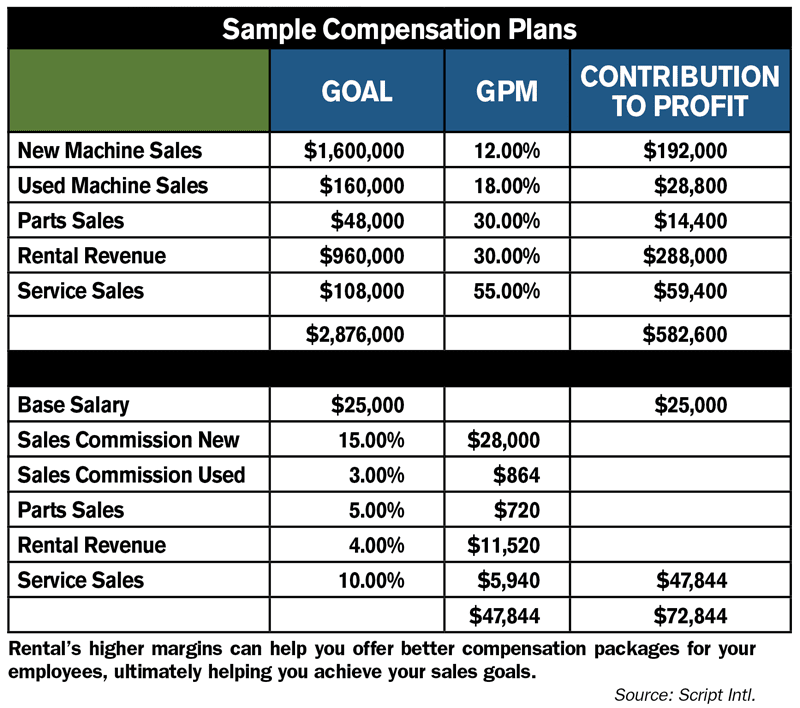I see it time and again when I work with dealers: Because you’ve seen so much success in the last 30 years, you think you can now coast to the finish line. In reality, though, the competitive forces and financial risks are more intense than ever.
First, a dealership can no longer count on strong parts and service revenues. The 9-year trend for parts and service revenues is flat, and wholegoods margins remain tight.
Another risk comes from the changing distribution model. Manufacturers have pursued other channels beyond the traditional 2-step distribution model and are now selling to rental companies and even end-users directly. Online retailing has become a formidable competitor for parts and even equipment sales. The dealership consolidation trend is continuing, too, adding even stronger competition.
What is your game plan for pushing back those pressures, protecting your margins and beating the competition? I encourage you to consider adding or expanding your rental offerings. Based on my 40 years in the rental industry — 20 of which have been spent working with dealers — I believe rental offers the best opportunity to increase your profits and provide what commercial and residential customers are demanding. In a booming economy, rental demand is naturally strong. When economic conditions soften, rental can be an alternative for those customers who are hesitant about taking on debt.
Dealer Takeaways
- Rental revenues can offer a higher gross margin than sales, and are very similar to parts sales.
- Create an efficient process for inspecting and servicing returned equipment, so that it can be placed back in rental inventory as quickly as possible.
- The rental department should have its own manager, who helps create a strategic plan.
- Complete a competitive analysis to find out the range of rental rates in your area and aim to be at the higher end of that range.
Getting rental right is not easy, however. There are pressures within the dealership that may work against its success. From the bottom up, here are dealers’ Top 10 challenges and strategies for overcoming them.
10. Competition
Do not underestimate your competition and the relationships they have built. That being said, there are ways to outperform them and win over their customers. You may offer a brand that carries more awareness, or that customers trust more. Maybe you can offer a more diverse lineup of equipment and attachments with better features. Perhaps you have a more convenient location. Make the most of your current sales relationships, promoting rental as an additional way to support your loyal customers. See if there’s a way to offer better prices, especially for long-term rentals or additional services, such as delivery.
You may already sell to rental companies — you shouldn’t lose this business. Tell them about your plans and find ways to continue supporting them. For instance, they could rent equipment from you when they’re all out of machines. This way, your rental inventory becomes their rental inventory.
9. Internal Loaners
Often, the sales team thinks rental equipment should be available to them as loaners or demonstrations. In those cases, even though your rental inventory is out in the field, it’s not earning any revenue. This practice makes it difficult to accurately measure the profitability of your rental department and might affect changes you make based on this incorrect data.
Make sure your staff knows that rental equipment is dedicated for rental sales only. Designate other equipment that can be used for loaners or demos, so you’re supporting customers in need while maintaining a profitable rental operation.
8. Management Technology
Rental is a very dynamic business. Equipment is continually being brought into inventory, rented, returned for service and rented again. Technology is necessary for an efficient reservations system and for you to monitor the profitability of the rental department. If you have multiple locations, you’ll need to see what’s available across your rental network, too. This way, if one location is out of something, you can point the customer to a different location of your dealership instead of losing their business.
7. Market Agility
Watch the competition and their rental fleet. Your sales team can help gather “intel” about the competition’s fleet, pricing, services, etc. Your sales and rental teams should also track calls for equipment that you don’t have available and when customers mention they are choosing a competitor instead. Those numbers can help indicate where you might need to expand inventory, change your processes or adjust your rates.
6. Strategic Focus
To be sustainable, rental needs to be part of a dealership’s strategic vision. Too often, rental is not viewed as a way to develop a new market or improve a dealership’s gross profit margin (GPM). This means it’s not part of any long-term planning regarding facilities, staffing or other investments. Ultimately, rental equipment is just viewed as additional wholegoods inventory. By simply recognizing rental as a key profit-producing department, you’ll start giving it the focus it demands and generating additional profits.
5. Rental Rates
Setting rental rates is not directly tied to how fast you want to recover your investment. Rental rates (range of pricing) for most machines are well established in local markets. With this in mind, you need to be competitive. Lastly, this is a supply/demand business, and if you enter a market with a machine that is not readily available, you can command a higher rental rate.

Identify the rate range for a machine and strive to be at the higher end. There’s no future in being the low-cost rental provider. If you’re already in the higher end, add more value such as through service, convenience and features.
4. Fleet Mix
You must have depth of fleet to be successful. If a customer calls for equipment and you don’t have it, they’ll turn to the competition. Eventually, they may call the competitor first. To achieve the right mix, research the kinds of jobs your customers are doing and the equipment they need to complete those jobs.
You also need machines that have utility, meaning they can be equipped with a variety of attachments — and you need to carry those attachments as well. This helps you reach additional markets, such as contractors, homeowners, farmers and many others.
3. Compensation Plans
A small bonus or commission for rental sales will not help you achieve your goals. Rental has to make a difference in an employee’s paycheck, or they won’t commit to it.
Refer to the chart “Sample Compensation Plans” on page 42 and notice the GPM generated by each of the revenue activities. The sales team should be paid to increase “profitable” business. As you can see, new machine sales are generally the lowest GPM transactions. Reward the sales team for driving additional revenues from their customers. Set commissions to drive the right behavior and keep the base salary (fixed cost) as low as possible. Don’t overpay. Pay for results.
2. Risk Management
The rental manager should report to at least a vice president-level position, not the sales manager. A sales manager is trying to drive market penetration, not rental, so there is an automatic conflict of interest. The rental manager’s salary and evaluation must be tied to the financial results of the rental department. They must have authority over the rental department staff and be responsible for the fleet mix.
Establish key performance indicators so everyone knows what is required. Bottom line: A clerk who is just handling rental contracts should not be running your rental department.
1. “Stuck” Rental Investment
Design efficient processes so your rental equipment is not held up between rentals. The typical process includes the following steps: out on rental; returned to the dealership; inspection, refueling, washing; maintenance/repair; and available for rent.
Think of the speed at which car rental agencies move cars in and out of the rental stream. Most have a car back in the fleet the same day it is returned. Unfortunately, for many dealerships I work with, the rental fleet is stuck at the dealership for up to 5 days between rentals. It is important to keep that process moving quickly so equipment is generating as much revenue as possible. However, if you’re able to move equipment through the process, but it sits too long before being rented, evaluate your marketing promotions or your rates.
Your goals for the rental department should vary by segment. The larger the equipment is, the more important time utilization is so you can achieve reasonable financial targets.
For equipment that costs over $100,000, I believe dealers need to try to hit 60+% time utilization. Depending on the climate you live in, that is over 200 days per year on rent. That’s not easy to accomplish without putting in real effort.
With equipment that is smaller, costing $45,000-$100,000, you might be able to get by with 45-50%. Smaller, specialized equipment can have a time utilization as low as 20% if the rates are high enough. Attachments for machines should be in the 20% range and can perform well.
Do You Have More Questions About Rental?
Larry Kaye explains more about what you need to be successful in rental, including location, equipment mixes, customer service and more. Go to www.RuralLifestyleDealer.com/RentalGrowsRevenues





Post a comment
Report Abusive Comment